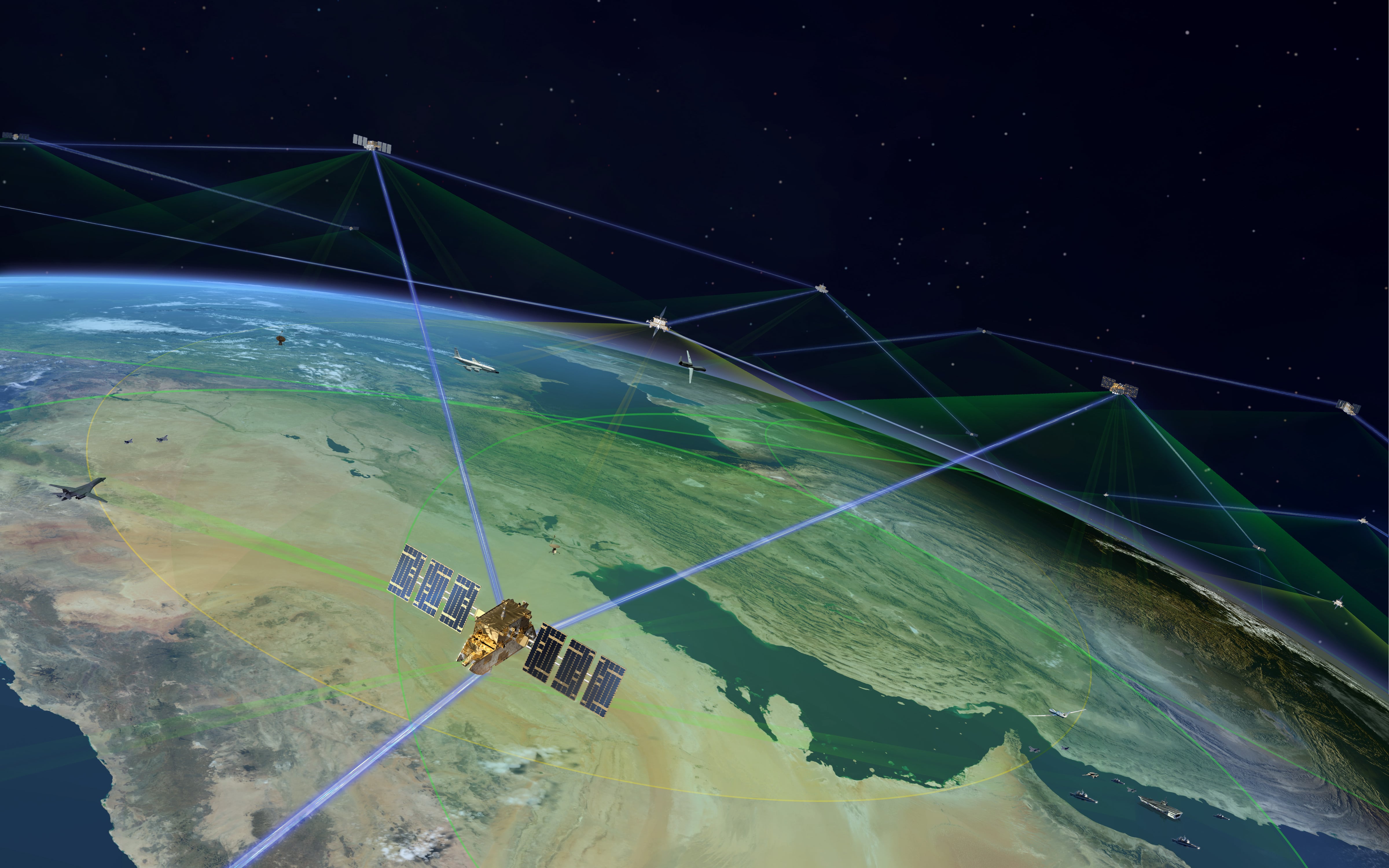In a series of trials this summer, the Space Development Agency and its industry team demonstrated two-way optical communications between a satellite and an aircraft in flight — a milestone for the agency’s efforts to establish a secure, high-speed, communications network that can connect systems across domains.
The successful proof-of-concept demonstration took place in July between a General Atomics Electromagnetics optical communications terminal that was mounted to an aircraft and a commercial satellite operated by Kepler Communications in an orbit around 311 miles (500 kilometers) above Earth. While SDA has shown several times it can connect satellites from its initial data transport constellation, or tranche, the airborne link up was a first.
“Now it becomes an effort to fold this into actual tranches where we can operationalize this,” Nathan Getz, director of SDA’s Data Transport Cell, told Defense News in a recent interview.
The communications capability is an integral part of SDA’s Proliferated Warfighter Space Architecture, or PWSA. The laser communications links and optical terminals allow satellites to pass data amongst themselves, with users on the ground and with aircraft and other systems. The goal is much faster, higher-volume data transmissions than traditional systems, which rely on radio frequency beams and in-demand spectrum access to send information.
Along with demonstrating the link between those satellites and General Atomics’ airborne terminal, the experiment proved the ability to make a connection between two optical communication terminals, or OCTs, built by different firms — crucial for SDA, which is relying on a mix of commercial vendors and more traditional defense contractors to build out its architecture. The agency has established an open OCT standard to help with that compatibility.
“This demonstration not just achieved the milestone for SDA-compatible communications across the air and space domains, but very importantly proved the robustness of the SDA standard for communications between OCT’s built by two different companies,” Gregg Burgess, vice president of GA-EMS’ Space Systems division, said in a statement.
SDA is on a path to launch hundreds of data transport and missile tracking satellites in the coming years as part of the PWSA through an incremental development and fielding approach. It’s partnering closely with companies offering proven technology and is delivering capability in batches, also known as tranches, that can be replaced or augmented every two years or so with new, more advanced spacecraft.
The agency began launching its first satellites, dubbed Tranche 0, in April 2023, and the next batch, Tranche 1, is slated to start flying later this month. Together, the two tranches are meant to prove out SDA’s iterative development approach.
The successful air-to-space demonstration was part of an ongoing experimentation campaign involving both SDA Tranche 0 satellites as well as commercial spacecraft. That work contributed to significant progress earlier this spring on space-to-ground connections between SDA and commercial satellites and ground terminals. Since achieving its first successful space-to-air connect in July, Getz said, SDA has repeated the experiment several times.
“It’s become, I don’t want to say routine, but now every time we go up, we’re pretty much connecting, we’re exchanging data, gigabits of data,” according to Getz. “It’s a lot of expertise on the industry side as well as SDA. We kind of built this cookbook of how you make this work, and now we’re seeing some success.”
The demonstration comes as agencies both internal and external to the Defense Department are closely watching for proof that SDA’s development approach and operational concept are the best option for the military.
The Space Force this summer revealed it is evaluating additional options for proliferated satellite communications, including a separate space-based network called MILNET, which is so far relying largely on the SpaceX’s Starshield for satellites, terminals and operations support.
In February, the Government Accountability Office released a report that called into question whether SDA’s go-fast strategy was causing it to bypass key capability development milestones. The analysis recommended the agency hold off on launching its Tranche 1 satellites until it demonstrated required laser communications capabilities with the Tranche 0 spacecraft already in orbit.
GAO found that while SDA at that time had made progress in some areas — like developing an optical terminal standard, testing the capability in a lab and maturing some of the enabling technologies — it hadn’t been able to validate the technology on orbit as fast as it had hoped.
According to Getz, SDA has made “night and day” progress since the release of that report. At the time, he said, the agency was “on the steep part of the learning curve.” Since February, Getz said, SDA has learned a lot about the technology and its use on the Tranche 0 satellites.
“We’re using the SDA satellites constantly, not only for what I’m talking to you about — space-to-air, space-to-ground — but also space-to-space,” he said. “It’s ongoing all the time. There are contacts being scheduled. It’s getting more automated. So, it’s a little bit like a snowballing effect where it takes a little while to get going and then things start speeding up.”
Up next for SDA is to continue expanding the envelope of its experimentation and using what it’s learned to inform future satellite development and operations, Getz said.
While the initial space-to-air connect involved a commercial satellite, Getz said SDA is working toward demonstrating the capability with its Tranche 0 satellites, which are located around 621 miles (1,000 kilometers).
SDA is also planning more work with commercial firms whose terminals comply with SDA’s standards.
“We’re using our own satellites, we’re also working with commercial partners here to bring capabilities and advance capabilities,” he said. “A major message here is that SDA does both and that there is a pretty robust industry response to SDA and the SDA ecosystem. As we build out the tranches, we’re also looking to leverage commercial capabilities.”
Courtney Albon is C4ISRNET’s space and emerging technology reporter. She has covered the U.S. military since 2012, with a focus on the Air Force and Space Force. She has reported on some of the Defense Department’s most significant acquisition, budget and policy challenges.








